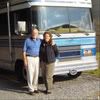Go to...  | Start A New Topic  | Search  | Notify  | Tools  | Reply To This Topic  |  |
 6/12 6/12Formally known as "Humbojb"  |
Given the same engine size and the same transmission, what's the difference between a 4:10 ratio and a 4:56 in terms of low end acceleration, torque, and fuel economy? I'm looking for my first Barth and have noticed that those produced in the 70's seem to have the 4:53 which I presume is coupled to a 3-speed automatic, ergo not very good fuel economy. Did Barth go to a 3-speed + overdrive later and did they also change the differential gearing? Thanks for any help. It will tell me what direction to go since fuel economy is important to me and we don't spend a lot of time in the Eastern mountains. Jim ------------------ | ||
|
| First Month Member |
Tire diameter is also part of the calculation. Without tire size, the ratio is not useful in comparing RVs. My 84 P30 30T has 19.5 wheels and 4.88 diff. I believe the other ratio you mentioned, 4.11, was used with 16 inch wheels. Perhaps 16 inch owners can confirm or correct. All else being equal, a higher number (like a lower gear) will give you better accelleration and hill climbing, but worse mileage. And a lower number will generally give you the opposite. The bottom line is engine rpm at your cruising speed. [This message has been edited by bill h (edited February 20, 2005).] | |||
|
 6/12 6/12Formally known as "Humbojb"  |
Thanks Bill! So, everything else equal, a 4:11 would give better gas milage than a 4:53. Can anyone fill me in on when Barth went to an overdrive tranny and what rear axle ratios were used with it? Jim | |||
|
My thought: The mileage diff between a 4:11 and a 4:53 is probably 1 MPG; remember you'll be turniing more RPM at ALL speeds and all gears. The P30 RV chassis had a 454 ("high deck" or truck engine, as opposed to passenger car big blocks) and Turbo Hydramatic 400 - both of which were bulletproof - as late as 1988. ------------------ "You are what you drive" - Clint Eastwood [This message has been edited by Gunner (edited February 20, 2005).] | ||||
|
| The Old Man and No Barth |
I'd be surprised if the difference between a 4.11 & a 4.53 would be as much as 1 mpg. , though a 4.11 should give a measurably better average, over time. The whole equation is complicated by the amount of weight you're hauling, and engine vacuum at cruise. On average, the higher the weight, the poorer the mileage, and the higher the vacuum, the better the mileage. The more you stay out of the secondaries the better. According to my paperwork, I'm running a 4.10 axle. I haul about 20,000 lbs., in a 1990, 33' Regal, loaded normally, on 19.5 in. tires, with a toad on behind. I'm still looking for a tankful that will average at least 6 mpg. My overall average is about 5.85, up hill, down dale, and in between. I've had 454s in pickups & Suburbans that gave me 8 or 9 mpg loaded, empty, or towing.The only thing that made a significant difference was speed. The slower, the better. If I could discipline myself to stay at 55 mph., I might make that 6 mpg. Gear Vendors claims better mileage with their under/overdrive. I've had one report that it makes for a quieter drive at cruise, but this person claimed no improvement in fuel economy. Unless you drive 100, 000 m iles a year, changing a rear axle to achieve better fuel economy is not likely to be economical. [This message has been edited by olroy (edited February 20, 2005).] | |||
|
"I'd be surprised if the difference between a 4.11 & a 4.53 would be as much as 1 mpg..." The difference is 10%, unless I missed a decimal or, more likely, the math is correct but the logic is flawed. Anyhow, don't let the RELATIVELY small cost difference in fuel keep you from a coach you like. Also:"My thought: The mileage diff between a 4:11 and a 4:53 is probably 1 MPG; remember you'll be turniing more RPM at ALL speeds and all gears..." As above, tire diameter is a big factor; probably GM went to larger diameter tires when they went to a 4:53, resulting in the same engine RPM-per-mile and the same gas mileage?? Am I off-subject? If so, apologies. ------------------ "You are what you drive" - Clint Eastwood [This message has been edited by Gunner (edited February 21, 2005).] | ||||
|
"First Year of Inception" Membership Club |
The only running gear on a Barth that would effect my buying decision is if I were buying a diesel pusher and the choice was a 4 or 6 speed Allison. I have been told that on the 6 speed at cruising speed there is 500-700 rpm difference. But it isn't fuel savings that would be the factor. I have been told you can barely "hear" the engine when cruising in 6th. 454's, 460's and all of the big block engines get well under 10 mph. I wouldn't ever advise anyone to make a buying decision based on resale values, R-values or mileage. You buy based on the coach construction, floorplan and price. | |||
|
 6/12 6/12Formally known as "Humbojb"  |
My 1990 Callista Class C (which is for sale) has a 460 coupled to a Ford 3-speed + overdrive tranny on 16" tires and gets about 9 1/2 mpg running of the interstates at 60mph. It's GVWR is 11600# but I'm usually a little under 10000# Don't know what RPM because it doesn't have a tach. Granted, it's a little lighter. But the most important thing is that it isn't a Barth, which is why I'm looking for a 28' Regal. Still wondering if/when Barth put a 3-speed +overdrive in the Regals. | |||
|
| First Month Member |
Just ran onto something in my files: 14-bolt cover 8-lug drum brake should have 4.10 gears 10-bolt cover 10-lug disc brake should have 4.56 Hope this helps. | |||
|
 6/12 6/12Formally known as "Humbojb"  |
Gunner--were all P30's equipped with the High Deck engine? Wouldn't that make finding replacement parts hard since the big block 454's in cars would have been a lot different? Why did GM use the High Deck engine? Jim | |||
|
Yes, No, and: Just as Impala/Caprice passenger cars with the Handling Package had "4-bolt main" 305s and others, visually identical, had Pontiac 307s, the 454s differed slightly depending on usage. The "high deck" block was just a tad taller; it was used in trucks and some Suburbans. The idea was to allow milling the block/head since the assumption was they would be used over more miles and thus rebuilt, plus the block casting was stronger. Some had slightly different head parts (springs, etc.)The rest was a standard "Rat" engine, and the difference was hard to tell visually. Some trucks and suburbans had different (higher output) alternators, etc. than passenger cars. The P30 was a truck, of course, and had truck parts as opposed to passenger car parts. This is why the clerk down at Pep Boys always asks "What's it out of?" (and still sells you the wrong part) ------------------ "You are what you drive" - Clint Eastwood [This message has been edited by Gunner (edited February 25, 2005).] | ||||
|
| "First Year of Inception" Membership Club |
GUNNER MY BLOCK CASTING NUMBERS ON THE LEFT SIDE JUST BEHINE THE HEAD ARE 361959 WOULD THIS BE A TALL BLOCK THE ENGINE HAS NEVER BEEN CHANGED. RALPH GLOVER 1976 BARTH 27' | |||
|
| "5+ Years of Active Membership" |
hi. ( tall deck block ) T.D.B has longer connecting rods give more low end torque.hot rod guys love them move rist pin up on piston get more T. carl 87 33.t | |||
|
My 30-yrsago memory left out the primary advantage of the tall deck- more torque! It was designed for greater block strength but the result was greater torque. Thanks for completing the story with what is important to us heavy-laden drivers. Gunner ------------------ "You are what you drive" - Clint Eastwood | ||||
|
| First Month Member |
I just read an item that triggered a memory of the tall block discussion here: In the may issue of Chevy High Performance magazine, the tech guy says the 454 tall block was produced only for medium duty C70 trucks in 79 and 80. I know for sure that a fair number of tall blocks were original equipment in boats. There were a lot of tall block 366s and 427s, however. I never heard of either in a MH. The reason for the tall block usually stated is to allow room for a fourth piston ring, keeping the piston straighter in the bore and cutting oil consumption. The tall block engines were rated at lower horsepower, but were intended to operate at a higher continuous power output than other truck engines. They also had 4 bolt main bearing caps to deal with the heavier service. The blocks were .4" taller. An easy way to identify the tall block truck engines is to look at the area where the water pump fits against the front of the block. The low block engines have the heads right against the machined water pump flange,while the tall block engines have about 1/4-3/8 inch of unmachined cast between the machined flange and the head. I seem to remember they also had two thermostats in trucks. [This message has been edited by bill h (edited April 09, 2005).] | |||
|
| Powered by Social Strata |
| Please Wait. Your request is being processed... |
|
This website is dedicated to the Barth Custom Coach, their owners and those who admire this American made, quality crafted, motor coach.
We are committed to the history, preservation and restoration of the Barth Custom Coach.
We are committed to the history, preservation and restoration of the Barth Custom Coach.

